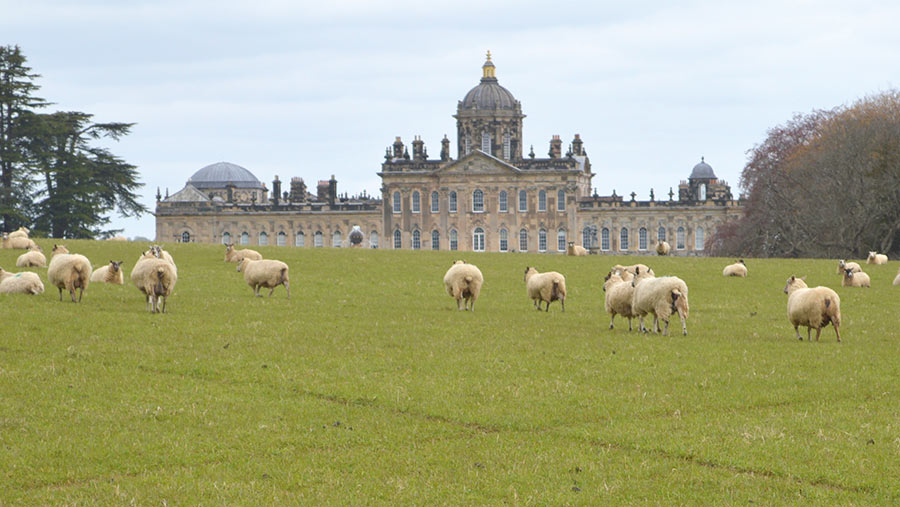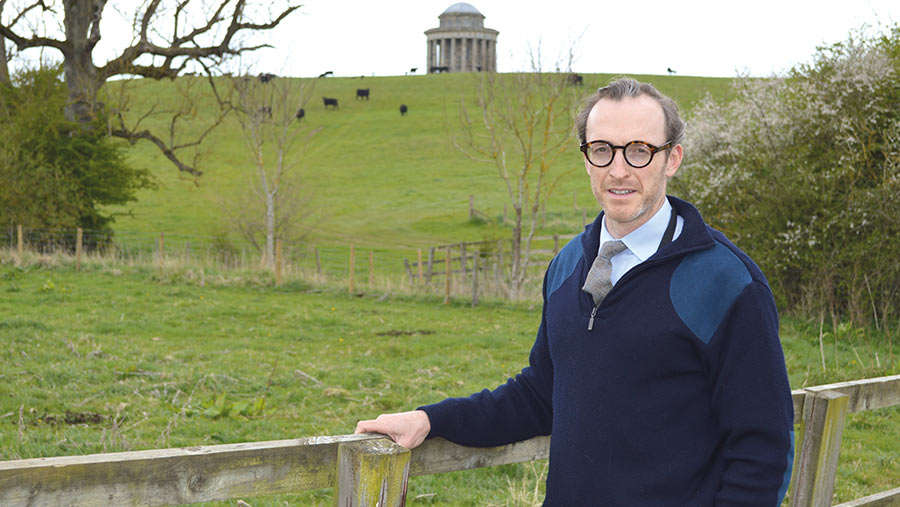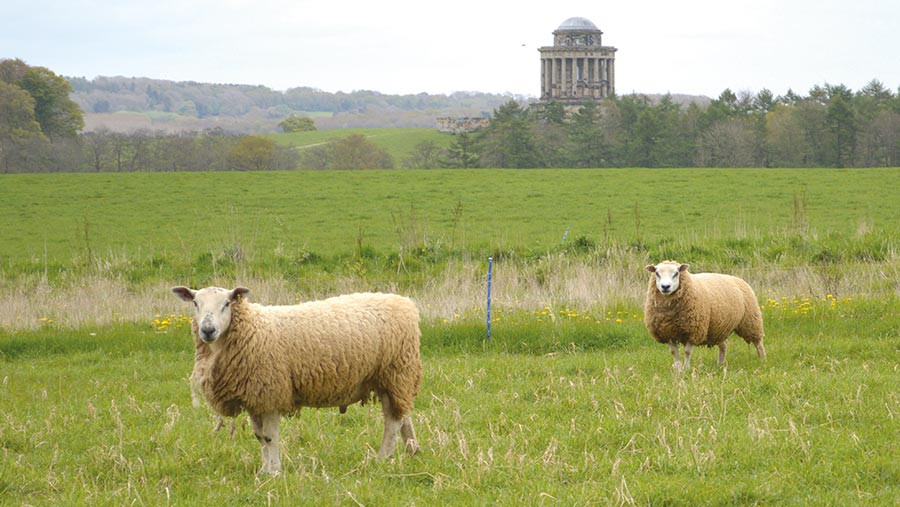Famous North Yorks estate prepares for new environmental schemes
 © MAG/David Jones
© MAG/David Jones One large North Yorkshire estate has mapped out its biodiversity and carbon footprint to give it a head start in applying for complex “public money for public goods” environmental schemes.
Castle Howard is the guinea pig, in collaboration with its tenants and share farming partner, for a new natural capital assessment tool.
The tool aims to put the 3,500ha estate in a good position to apply for Local Nature Recovery and Landscape Recovery schemes.
See also: Hereford grower paid to drill cover crops to protect drinking water
Estate facts: Castle Howard
- Total area 3,520ha
- 1,280ha farmed by seven tenants
- 920ha farmed in a share-farming agreement with neighbouring farmer
- 840ha woodland
- 240ha parkland
- 145-room Castle Howard house, properties, mausoleum, temple and other buildings
The schemes are the two more extensive tiers of the Environmental Land Management (ELM) schemes that are replacing the area-based Basic Payment Scheme (BPS).
Jasper Hasell, the estate’s chief executive, says the £4-£5/ha spent on the digital map will prove good value.
It will be employed as the iconic estate looks to increase regenerative farming practices and prepare for future environmental and land management schemes.
“The data and scenario testing we derive from the tool enables us to confidently embark on significant land management changes that will shape the estate over the next 50-100 years,” he tells Farmers Weekly.
Environmental Land Management schemes
Strategic Farming Initiative
Will pay farmers who take measures to improve their soils and land management.
Open to all from June 2022, although the nearly 1,000 farmers in the pilot scheme will have access to more options.
These should become more widely available, with the full range from 2025 onwards.
Local Nature Recovery
Seen as a more ambitious successor to Countryside Stewardship, with a focus on targets for trees, peatland restoration, habitat creation and restoration and natural flood management.
A limited number of these schemes will be available in 2023, and then will be rolled out across England by end-2024.
Landscape Recovery
These will be bespoke agreements for long-term land use changes and habitat restoration.
Two rounds of applications are likely over the next two years.
Testbed
The estate is the first to use the Land360 assessment tool from consultant group Fera Science to map out its natural capital such as woods, lakes, fertile soils and public access.
The estate was used as a testbed before the service was officially launched at the Oxford Farming Conference earlier this year.
While most attention has focused on the first of the three-tiered ELM schemes – the Strategic Farming Initiative, where growers will be paid to improve soils and land management – the other two schemes are expected to be more wide-ranging.

Estate chief executive Jasper Hasell © MAG/David Jones
The government has promised to hold the annual level of farming support in England at £2.4bn until the end of this parliament, which could last until December 2024.
After BPS is phased out completely in 2028, future support will be split equally between SFI, Local Nature Recovery and Landscape Recovery.
The first of these, the SFI, was launched at the end of June as part of the replacement for BPS payments, which were £233.30/ha in 2020 before being tapered down over the next few years to disappear completely by 2028.
But it is the other two that have attracted the attention of Castle Howard.
The digital map, known as the Natural Capital Baseline, provides a range of metrics including biodiversity, stock and flux of carbon in various habitats across the estate.
The estate has been divided into 6,039 parcels, from hedges to woods to parklands, all of which may be participating in these two schemes in the future.
Awaiting detail
Mr Hasell sees the Local Nature Recovery and Landscape Recovery schemes as of particular relevance for a large estate such as Castle Howard.
However, financial details of the schemes are still limited, which makes commitment to either difficult until more information is made available.
They could involve increased use of regenerative farming techniques, such as minimum tillage, reduced inputs and increased cover cropping,.
They may also place land which is not profitable for modern food production into conservation grazing or potentially rewilding.
The 18th century house and estate in the Howardian Hills, 15 miles north of York, is famous as the backdrop for Brideshead Revisited and more recently Bridgerton.
It is well suited to using a variety of land management practices under such schemes, as it has soil types ranging from limestone brash to light sandy soils and then heavy clays in its shallow valleys.
Mr Hasell says: “We definitely want to embrace these two schemes on the estate if we can, and we want to be pioneering in what we do, but these are long-term decisions and it is important we get them right, so we do not want to rush into them.”
Extensive parkland
A Landscape Recovery scheme could be based around the heavily wooded nature of the estate and its extensive parkland.
The scheme could also cover its tenant farmers alongside the in-house share farming partner, Ness Hall.
Field shapes could be adjusted to farm only the most efficient rectangles of land to reduce short runs, compaction and reduce inputs.
The remaining margins could be put into conservation schemes to benefit nature.
Defra has described this long-term scheme as paying landowners to take a radical and large-scale approach through land use changes and habitat and ecosystem restoration.
It envisages a launch for the first 15 projects soon.
The drive to refocus on environmental credentials came with the return of Nicholas Howard and his wife Victoria to run the estate in 2015, and reflects their passion for wildlife and conservation.

© MAG/David Jones
Historic house
Farming is just one of the businesses on the estate, which has 840ha of managed woodland, a Grade I listed house that attracts more than 250,000 visitors a year, and more than 150 let properties in surrounding villages.
But this all comes with huge maintenance and repair costs, with an estimated bill of £50m to return all the buildings on the estate to their former glory.
Glyn Jones, head of science (plant) at Fera, has been instrumental in assessing Castle Howard’s natural capital potential by starting to map the estate in 2020.
This will give it a baseline for its environmental credentials to apply for these new schemes.
“The estate can use Land360 to know what it has in terms of carbon and biodiversity, with a view to them seeing what targets it can achieve through careful and informed land management changes,” says Dr Jones.
The estate’s woodlands already sequester more than 10,000 tonnes of carbon a year, which is equivalent to emissions from more than 1,000 family homes.
Mr Hasell says the estate can do more by making incremental changes to its arable operations which cover more than half of the land area.
Soil health
“There is an opportunity for Castle Howard to increase significantly carbon sequestration by improving our soil health across our arable land, which is why regenerative farming practices are being adopted,” he says.
Arable land is currently a net emitter of carbon when inputs and annual cropping are taken into account.
Therefore the aim will be to use regenerative farming methods to bring these high levels down to a point where carbon is actually being removed from the atmosphere each year.
The digital plan will also help with applications for Local Nature Recovery schemes, seen as a successor to Countryside Stewardship.
But again, the details of these schemes are light at the moment, with plans out late in 2022 and a limited early version available in 2023.
Currently, 200ha of the estate is in an old Higher Level Stewardship scheme which is set to end in 2023.
This area may be a candidate for the new scheme depending on payments and how it compares with Countryside Stewardship schemes, where the last applications are due in 2023 to start in 2024.

